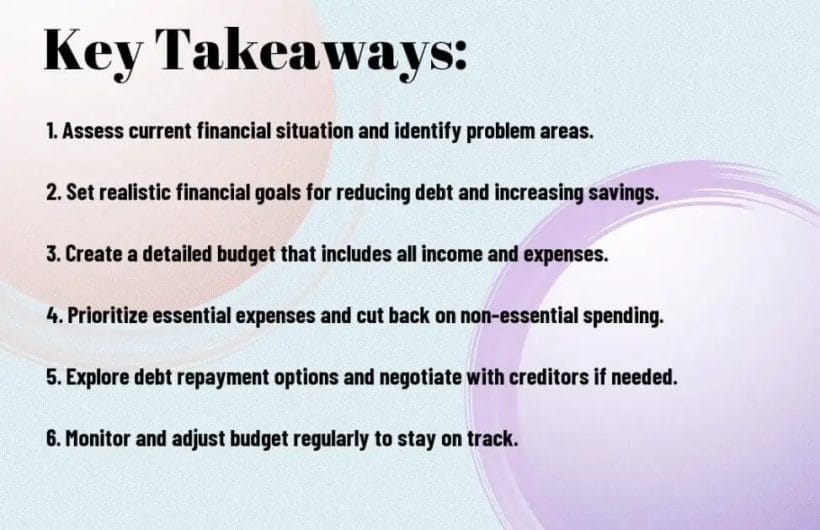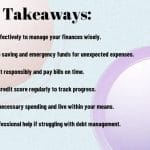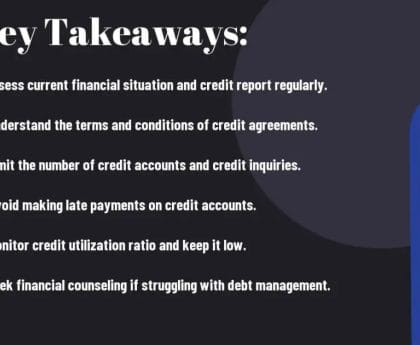Unfortunately, developing sustainable budgeting strategies can be difficult for many people dealing with financial difficulties and debt. However, with the right strategy and discipline, it is possible to create a successful strategy for managing your finances and tackling debt.
In this informative blog post, we will explore key tactics and tips for developing sustainable budgeting strategies that will help you take control of your financial situation and work towards a debt-free future.
From setting realistic financial goals to identifying spending habits and implementing effective budgeting tools, we will provide you with the essential advice to tackle your financial issues head-on.
- Foundations of Sustainable Budgeting
- Strategies for Reducing Expenses
- Strategies for Increasing Income
- Managing Debt Effectively
- Building and Maintaining an Emergency Fund
- Utilizing Financial Tools and Resources
- Monitoring Progress and Adjusting Your Budget
- Conclusion: Developing Sustainable Budgeting Strategies
- FAQ
Key Takeaways:
- Assess Your Financial Situation: Before creating a budget, it’s crucial to understand your income, expenses, and debt. Taking stock of your financial situation will help you identify problem areas and develop targeted budgeting strategies.
- Set Realistic Financial Goals: Sustainable budgeting involves setting achievable financial goals that align with your income and expenses. Whether it’s paying off debt or saving for a large purchase, having clear goals will keep you motivated and help prioritize your spending.
- Monitor and Adjust Your Budget Regularly: Creating a budget is not a one-time task. It’s essential to monitor your spending and income regularly and make adjustments as needed. By staying on top of your budget, you can adapt to changing financial circumstances and ensure long-term success.
Foundations of Sustainable Budgeting
Any successful budgeting strategy starts with a strong foundation. It’s important to assess your current financial situation and set realistic and achievable goals to develop a sustainable budgeting plan that will help you tackle financial problems and debt.
Assessing Your Current Financial Situation
On your journey to develop sustainable budgeting strategies, it’s essential to start by assessing your current financial situation. Take a close look at your income, expenses, debts, and savings. Calculate your total monthly income and compare it to your monthly expenses, including essentials such as groceries, bills, and housing. Identify any areas where you may be overspending or where you could potentially cut back. Understanding your financial position is the first step in creating a budget that will work for you in the long term.
Setting Realistic and Achievable Goals
With the knowledge of your current financial situation, the next step is to set realistic and achievable goals. Determine what you want to achieve with your budget, whether it’s paying off high-interest debts, building an emergency fund, or saving for a major purchase. It’s important to set clear goals that are specific, measurable, achievable, relevant, and time-bound. This will help you stay focused and motivated as you work towards improving your financial situation.
Foundations of sustainable budgeting – Assessing your current financial situation and setting realistic and achievable goals are the cornerstones of developing a successful budgeting strategy. By understanding where you stand financially and setting clear objectives for the future, you can create a budget that will help you overcome financial problems and debt. These foundational steps lay the groundwork for a sustainable approach to managing your finances, leading to a more stable and secure financial future.
Strategies for Reducing Expenses
Your journey to developing sustainable budgeting strategies for tackling financial problems and debt begins with identifying and cutting non-essential costs, as well as optimizing essential spending. By implementing these strategies, you can take control of your finances and work towards a more secure financial future.
Identifying and Cutting Non-Essential Costs
Reducing non-essential costs is a critical step in creating a sustainable budget. Start by carefully examining your spending habits and identifying areas where you can cut back. This may involve eliminating subscriptions or memberships that you do not regularly use, reducing dining out and entertainment expenses, and finding ways to lower utility bills. By being mindful of these non-essential costs, you can free up more money to put towards your financial goals, such as paying off debt or building an emergency fund.
Optimizing Essential Spending
An essential part of developing sustainable budgeting strategies is optimizing your essential spending. Take a closer look at your regular expenses, such as groceries, transportation, and healthcare. Consider ways to reduce these costs without sacrificing necessities. This could involve meal planning to cut down on grocery expenses, carpooling or using public transportation to save on commuting costs, and exploring lower cost healthcare options. By optimizing your essential spending, you can ensure that you are getting the most value for your hard-earned money, while still meeting your basic needs.
Identifying and cutting non-essential costs and optimizing essential spending are foundational steps in developing sustainable budgeting strategies. By reducing unnecessary expenses and finding ways to make essential spending more cost-effective, you can take control of your finances and make significant progress towards tackling financial problems and debt. Embrace these strategies as key elements of your overall financial plan, and you will be well on your way to achieving long-term financial stability.
Strategies for Increasing Income
Keep a proactive mindset when it comes to increasing your income. There are several strategies you can utilize to bring in more money and improve your financial situation.
Exploring Additional Income Streams
The key to boosting your income is to diversify your revenue sources. Seek out new opportunities to generate income, such as taking on a part-time job, freelancing, or starting a side business. Explore the gig economy and consider utilizing your skills and hobbies to earn extra cash. Additionally, consider selling unused items or renting out assets to bring in additional income. By diversifying your income streams, you can protect yourself from relying solely on one source of revenue and increase your overall earning potential.
Investing in Personal and Professional Development
Income growth is often tied to personal and professional development. Invest in expanding your skills, knowledge, and expertise to open up new opportunities for higher paying jobs or advancement in your career. Look for training programs, certification courses, or workshops that can enhance your qualifications and make you more valuable in the job market. Networking and building relationships within your industry can also lead to new career opportunities and potential income growth.
Additional education, certification, and networking can lead to higher paying jobs and advancement opportunities, leading to a significant increase in income over time. Investing in your personal and professional development is an essential strategy for achieving long-term financial stability and success.
Managing Debt Effectively
To effectively manage debt, it is crucial to prioritize high-interest debts and consider consolidation and negotiation techniques.
Prioritizing High-Interest Debts
High-interest debts such as credit card balances and payday loans can quickly spiral out of control, leading to a cycle of increasing debt and financial strain. When tackling multiple debts, it is essential to prioritize those with the highest interest rates. By focusing on paying off high-interest debts first, you can save money on interest charges and make significant progress towards becoming debt-free.
Consolidation and Negotiation Techniques
With the help of consolidation and negotiation techniques, it is possible to streamline and restructure multiple debts into a single, manageable payment. Debt consolidation involves combining all debts into one lump sum and paying them off with a single loan or line of credit, often with a lower interest rate. Negotiation techniques can also be employed to work with creditors and lenders to reduce interest rates, waive fees, or establish a more feasible repayment plan.
This approach not only simplifies the debt repayment process but can also result in substantial savings and reduced financial stress.
Building and Maintaining an Emergency Fund
Not having an emergency fund in place can leave you vulnerable to unexpected financial setbacks such as medical emergencies, car repairs, or job loss. Without a safety net, you may be forced to rely on high-interest credit cards or loans, further worsening your financial situation. Building and maintaining an emergency fund is a crucial component of sustainable budgeting and financial stability.
Determining the Size of Your Emergency Fund
Determining the size of your emergency fund depends on various factors such as your monthly expenses, income stability, and the likelihood of experiencing unexpected financial hardships. A general rule of thumb is to aim for an emergency fund that can cover three to six months’ worth of living expenses. However, individuals with higher income variability or job insecurity may benefit from aiming for a larger emergency fund.
Emergency fund should be approached methodically. Consistent savings strategies such as setting up automatic transfers from your checking account to a dedicated savings account, or using windfalls such as tax refunds or bonuses to bolster your emergency fund can help you build a financial safety net over time. This proactive approach can provide a sense of security and peace of mind, knowing that you have a financial cushion to fall back on when unexpected expenses arise.
This proactive approach can provide a sense of security and peace of mind, knowing that you have a financial cushion to fall back on when unexpected expenses arise. By consistently saving and maintaining an emergency fund, you will be better equipped to handle financial emergencies without resorting to high-interest debt or compromising your long-term financial goals.
Utilizing Financial Tools and Resources
After creating a solid budget and setting financial goals, the next step is to utilize the various financial tools and resources available to help you stay on track. Whether you’re looking for budgeting software and apps or seeking educational resources and professional advice, there are a variety of options to choose from.
Budgeting Software and Apps
For individuals or households looking for a convenient way to track their expenses and stick to a budget, utilizing budgeting software and apps can be incredibly beneficial. There are numerous options available, from free apps like Mint and EveryDollar to more robust software like Quicken and YNAB. These tools can help you track spending, set savings goals, and even receive alerts when you’re approaching your budget limits. By utilizing these resources, you can gain a better understanding of your financial habits and make more informed decisions moving forward.
Educational Resources and Professional Advice
Resources such as financial literacy courses, books, and online articles can provide valuable insight and knowledge on budgeting, saving, and investing. Additionally, seeking professional advice from financial advisors or credit counselors can offer personalized guidance and strategies for tackling financial problems and debt. These resources can help individuals gain a deeper understanding of personal finance and make more informed decisions about their money. By taking advantage of these educational resources and seeking professional advice, individuals can develop a more sustainable approach to budgeting and financial management.
Advice from knowledgeable professionals can provide personalized strategies and solutions for tackling financial problems and debt. Seeking out educational resources such as books, courses, and online articles can empower individuals to make more informed decisions about their finances. By utilizing these resources and seeking professional advice, individuals can develop a more sustainable approach to budgeting and financial management.
Monitoring Progress and Adjusting Your Budget
Now that you have established a budgeting strategy for tackling financial problems and debt, it is important to regularly monitor your progress and make necessary adjustments to your budget. This will ensure that you stay on track and continue to make positive financial strides.
Regular Financial Reviews
Your financial reviews should be conducted on a regular basis, whether it’s weekly, bi-weekly, or monthly. During these reviews, take the time to analyze your spending habits, income, and any changes in your financial situation. Look for any discrepancies between your budget and your actual spending, and adjust as needed to align with your financial goals. By regularly reviewing your finances, you can stay accountable and avoid straying off course.
Adapting to Changing Circumstances
For any changes in your income, expenses, or financial goals, it’s essential to adapt your budget accordingly. Life is full of unexpected circumstances, and it’s important to be flexible in your budgeting approach. Whether it’s a raise at work, a new expense, or a shift in your financial priorities, be prepared to make adjustments to your budget to accommodate these changes. By doing so, you can continue to make progress towards your financial stability and long-term goals.
The flexibility of your budget is key in ensuring that you can adapt to any changes in your financial situation. It’s important to be proactive in making necessary adjustments, and not wait until it’s too late. By regularly monitoring your progress and being adaptable, you can maintain control over your finances and work towards long-term financial success.
Conclusion: Developing Sustainable Budgeting Strategies
With this in mind, developing sustainable budgeting strategies is essential for tackling financial problems and debt. By carefully analyzing income, expenses, and debt obligations, individuals can create a realistic budget that allows for both saving and paying down debt. It’s important to prioritize essential expenses and cut back on non-essential items in order to free up more funds for debt repayment. Additionally, seeking professional financial advice and utilizing personal finance tools can help individuals gain a better understanding of their financial situation and make informed decisions. By following these sustainable budgeting strategies, individuals can work towards financial stability and ultimately achieve their long-term financial goals.
FAQ
Q: What are sustainable budgeting strategies for tackling financial problems and debt?
A: Sustainable budgeting strategies for tackling financial problems and debt involve creating a realistic budget based on your income and expenses, identifying areas where you can reduce spending, setting achievable financial goals, and consistently tracking and adjusting your budget to stay on track.
Q: How can I develop a sustainable budget for my financial situation?
A: To develop a sustainable budget, start by documenting all sources of income and categorizing your expenses. This will help you identify areas where you can cut back and allocate more funds towards paying off debt. It’s important to prioritize essential expenses, build an emergency fund, and allocate a portion of your income towards debt repayment.
Q: What are some tips for maintaining a sustainable budget and overcoming financial challenges?
A: To maintain a sustainable budget and overcome financial challenges, it’s essential to regularly review your budget, track your spending, and make adjustments as needed. Additionally, consider seeking professional financial advice, exploring debt consolidation options, and looking for additional sources of income to boost your financial situation.






